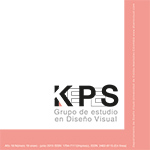Authors
Abstract
This article exposes an ontological and methodological perspective that involves life stories as a method and situated knowledge as an approach, with the intention of proposing a platform for the epistemological replacement of "other designs".
In the configuration of what is understood as design, some structures of the social type can be recognized, in the middle of which centers of production of knowledge in design are instituted that have been in charge of defining and arranging theoretically and operationally what is recognized as design. Also, peripherally, other organizations that produce design develop and unfold. These peripheries behave according to the degree of closeness with the centers of production institutionalized in the definition of the design.
Peripheral organizations as environments for living the design of a defined group of individuals, individuals with a 'different' experience of design due to their peripheral condition. Likewise, conditions are recognized that tend to particularize the knowledge that is produced from these 'places'.
From the theory of situated knowledge, which proposes an epistemological privilege of those individuals who are subjected to the structures of domination that marginalize them, privilege given by their experience and the ability to understand it that only they can account for, different things can be known or certain things can be known better in front of those more favored (socially or politically).
In order to make visible and tacit the product of the experience of these individuals, life stories, as a method, are presented as an ideal resource for the reconstruction of experience lived. Through them it is possible to access the relationships between the subjective and the social institutions, the imaginaries and the symbolic representations, allowing readings of the social and describing the knowledge placed on the design that has been built between these facts of the social.
Keywords:
References
Alexander, C. (1971). The state of the art in design methods. Design Methods Group Newsletter, 5 (3), 1-7.
Archer, B. (1968). The structure of design processes. London, England: Royal College of Art.
Berger, T. y Luckmann, T. (2003). La construcción social de la realidad. Buenos Aires, Argentina: Amorrortu.
Bertaux, D. (1996). Historias de casos de familias como método para la investigación de la pobreza. Revista de Sociedad, Cultura y Política, 1 (1), 3-32.
Brown, T. (2008). Design thinking. Harvard Business Review, 86 (6), 84-92.
Bourdieu, P. (1987). “Habitus, code, codification”. Actes de la Recherche en Sciences Sociales, 64, 40-44.
Buchanan, R. (1992). Wicked Problems in Design Thinking. Design Issues, 8 (2), 8-21.
Buchanan, R. (2004). Design as inquiry: The common, future and current ground of design. Recuperado de http://www.designresearchsociety.org/futureground/pdf/buchanan.pdf.
Buchanan, R. (2007). Strategies of Design Research: Productive Science and Rhetorical Inquiry. En R. Michel (Ed.), Design Research Now (pp. 55-66). New York, USA: Springer.
Bürdek, B. (1976). Introducción a la metodología del diseño. Buenos Aires, Argentina: Editorial Nuevavisión.
Cross, N. (2001). Designerly ways of knowing: Design discipline versus design science. Design Issues, 17 (3), 49-55.
de Sousa, B. (2010). Descolonizar el saber, reinventar el poder. Montevideo, Uruguay: Trilce.
Devalle, V. (2015). Autocrítica. Asumir las fortalezas y debilidades de nuestra disciplina. IF, 10, 26-27.
Dorfles, G. (1977). El diseño industrial y su estética. Barcelona, España: Ed. Labor.
Dorta, T., Pérez, E. and Lesage, A. (2008). The Ideation Gap: Hybrid tools, Design Flow and Practice. Design Studies, 29 (2), 121-141.
Dorst, K. (2008). Design research: A revolution-waiting-to-happend. Design Studies, 29, 4-11.
Ferrarotti, F. (1991). La historia y lo cotidiano. Barcelona, España: Península.
Foucault, M. (2006). Sobre la Ilustración. Madrid, España: Tecnos.
Galle, P. (2008). Candidate worldviews for design theory. Design Studies, 29 (3), 267-303.
Gutiérrez, A. (2014). Chakana o la búsqueda del diseño con otros nombres. Recuperado de http://www.academia.edu/11660099/CHAKANA_O_LA_B%C3%9ASQUEDA_DEL_DISE%C3%91O_CON_OTROS_NOMBRES_Espa%C3%B1ol_2014_.
Gutiérrez, A. (2015). Resurgimientos: sures como diseños y diseños otros. Nómadas, 43, 113-129.
Goel, V. and Pirolli, P. (1992). The Structure of Design Problem Space. Cognitive Science, 16, 395-429.
Heidegger, M. (2009). La esencia de la verdad. Barcelona, España: Herder.
Jones, C. (1963). A Method of Systematic Design. En C. Jones and D.G. Thornley (Eds.), Conference on Design Methods (pp. 53-73). Oxford, England: Pergamon Press.
Fleck, L. (1987). La génesis y el desarrollo de un hecho científico. Madrid, España: Alianza Editorial.
Maldonado, T. (1993). El diseño industrial reconsiderado. Barcelona, España: Gustavo Gili.
Marcos Arévalo, J. (2004). La tradición, el patrimonio y la identidad. Iztapalapa: Revista de Ciencias Sociales y Humanidades, 57, 925-956.
Margolín, V. y Margolin, S. (2012). Un “modelo social” de diseño: cuestiones de práctica e investigación. Revista KEPES, 9 (8), 61-71.
Miller, R. (2000). Researching Life Stories and Family Histories. London, England: SAGE.
Munari, B. (1983). ¿Cómo nacen los objetos? Barcelona, España: Gustavo Gili.
Norman, D. (1986). User centered system Design: New perspectives on Human-Computer Interaction. Hillsdale, USA: L. Erl-baum Associates.
Papanek, V. (2001). Edugrafologia: los mitos del diseño y el diseño de los mitos. En M. Morán (Ed.), Fundamentos del diseño gráfico (pp. 50-55). Buenos Aires, Argentina: Ediciones Infinito.
Pejtersen, A. (1984). Design of a computer-aided user-system dialogue base on an analysis of user’s search Behaviours. Social Science Information Studies, 4, 167-183.
Piazzini, C.E. (2014). Conocimientos situados y pensamientos fronterizos. Geopolítica(s), 5 (1), 11-33.
Rittel, H. and Webber, M. (1973). Dilemmas in a General Theory of Planning. Policy Sciences, 4, 155-169.
Rivera-Plata, A. (2018). Diseño, identidad e ideología: el diseño como discurso. Pensamiento, Palabra y Obra, 20, 94-103.
Sánchez-Migallón, S. (2007). Max Scheler. Recuperado de http://www.philosophica.info/archivo/2007/voces/scheler/Scheler.html.

 pdf (Español (España))
pdf (Español (España))
 FLIP
FLIP
 Perfil Google Scholar
Perfil Google Scholar


















